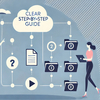
Today, consumers are scattered across various online platforms, such as websites, social media, mobile apps, online stores, etc. Content is generated in different formats for each platform. For example, websites use HTML, while eBooks and PDF formats are suitable for online stores.
Multi-channel publishing involves creating basic content and repurposing it in various formats. However, it is not as simple as it sounds. It requires rewriting and re-planning. Your technical writers do not simply have to ‘shovel’ content from one format to another. Proper reuse involves rebranding and restyling the content to ensure a professional appearance.
Proper content reuse will make your product personalized and targeted at different audiences. This is crucial for businesses that aim to maximize their online reach and engagement.
To make multi-channel publishing effective, companies need to develop a strategic approach. Only this way they will effectively connect with their target audience, boost brand visibility, and drive conversions.
In this article, we will provide you with a comprehensive plan to successfully implement multi-channel publishing and unlock the full potential of your online presence.
Understand Your Target Audience
The first step in implementing a strategic plan for multi-channel publishing is understanding your target audience.
Imagine a situation where your product launch turns out to be less successful than expected. You start receiving negative feedback from customers who complain that the product features they get do not solve their problems.
This is often the result of neglecting a crucial element in the pre-planning stage of the project: market research. Ignoring or approaching it in a perfunctory manner can lead to a flawed understanding of your customers’ needs.
Therefore, before delving into multi-channel publishing, it is vital to gain a deep understanding of your target audience. Conducting thorough market research and utilizing analytics tools can provide valuable insights into your audience’s preferences, behaviors, and demographics. By understanding their preferred channels, you can tailor your content to resonate with them and meet their specific needs.
Creating detailed buyer personas is an effective way to segment your audience and develop targeted content. Consider factors such as age, gender, location, interests, and online behavior. These personas will help you construct a representation of your customers.
Of course, this representation will be schematic, like a drawing. It may lack detail, but even in its abstract form, it will closely resemble real-life customers. This will assist your team in identifying the most distinctive features of your customers.
In fact, a persona encompasses the following features:
- Name. It is useful to give names (nicknames or codes) to personas. This allows for easy referencing throughout the market research document.
- Role. This refers to the persona’s relationship with the product, such as being a user, buyer, influencer, and so on.
- Goal. The persona’s goal represents the problem they are trying to solve. The more problems you can identify, the more targeted your product will be. Simply put, the goal reflects what the persona wants to achieve.
- Background and Attitude. This entails the conditions that shape the persona’s reaction (attitude) towards your product. The situation in which the customer is attempting to solve a problem can vary. It could involve compatibility issues with software installed on their PC (whether your product is compatible with their software), budget differences (which may lead companies to offer various subscription plans for their products), and more.
- Behavior. This feature includes possible behavior scenarios of the persona.
The outline above is not exhaustive, but these fundamental points will assist you in describing the market needs of your potential customers.
Identify and Optimize Your Channels
The next step in the journey toward multi-channel publishing is selecting the appropriate channels for distributing information about your product.
In the digital landscape, there is an abundance of channels to choose from, and it is crucial to identify the most relevant ones for your business. Popular channels include websites, blogs, social media platforms, email marketing, mobile apps, and video platforms, all of which offer significant potential for reaching and engaging with your audience. Below, we provide an overview of three of the most popular channels:
- Emails. Email campaigns can be highly effective as they allow direct delivery to customers. However, the issue of legitimacy arises, as these emails can be perceived as spam. Depending on local regulations, you should be prepared for situations where customers might complain or even take legal action.
- Blog posts. Creating blog posts requires more effort from your copywriters compared to email campaigns. Blogs are typically longer and gain popularity when the blogger shares their real-life experiences. Achieving this level of authenticity can be challenging.
- Posts in social media. The advantage of social media posts is the potential to reach a wide audience, often larger than what a targeted campaign can achieve. An interesting post can even go viral and attract an entirely new market segment. However, the downside is that the outcomes of social media posts are difficult to predict.
When selecting channels, consider the preferences of your potential customers. For example, if your audience consists of young professionals, platforms like Instagram or LinkedIn may be more suitable, while Facebook or Twitter could be more effective for broader consumer demographics.
Once you’ve identified the channels, focus on optimizing each one to maximize their impact. Implement effective search engine optimization (SEO) strategies to enhance your visibility in search engine results. Your blog or post will have limited impact if you fail to provide the necessary keywords and links. Interlinking the new blog with previous ones will increase the average time readers spend on the website and, consequently, improve your position in search engine rankings.
Furthermore, develop engaging and shareable content that aligns with each channel’s unique features and audience expectations. Consistency in branding across all channels is crucial for building brand recognition and trust among your audience.

Develop a Consistent Brand Image
The third step is to develop a consistent brand image. A cohesive brand identity helps to establish credibility, boosts brand recognition, and fosters a sense of familiarity among your audience.
Your copywriters need to maintain consistency in the wording of the content. Consistency means using the same formulations, definitions, and overall tone of voice throughout your materials. This consistency should be maintained across all channels.
Additionally, remember that content styling extends beyond just the wording. Ensure that your brand elements, such as logos, colors, and typography, are consistent across your website, social media profiles, email communications, and other touchpoints.
These elements form the visual language of your documentation. Unique typography allows your company and products to express themselves through fonts. You can also utilize combinations of slogans and visuals (such as hero images), background videos, and more.
Remember that consistency in presenting your content creates an impression of integrity. Without consistency, pages may appear as separate documents. By establishing brand consistency, you reinforce your messaging and make it easier for your audience to recognize and connect with your brand, regardless of the channel they encounter you on.
Create Engaging and Relevant Content
The last but one step in multi-channel publishing is creating high-quality content. Develop a content strategy that aligns with each channel’s unique requirements and your audience’s preferences. Tailor your content formats, tone, and style to suit the platform and capture the attention of your target audience.
The fact is that content creation has become much more effective with the introduction of component authoring. This has made the process of technical and copywriting much easier. Modern help authoring tools can utilize the entire knowledge base of your company, treating all created texts and codes as components for future content (hence the term ‘component authoring’, by the way).
Your writing team will no longer need to start from scratch. The authoring software will assist writers in building new content using existing materials, similar to constructing structures from ready-made bricks, blocks, beams, and so on.
Component authoring, or content reuse, is closely related to the principle of single-sourcing, which enables you to derive new content units from initial ones. Additionally, single sourcing helps address the issue of updating. You no longer need to edit and update each similar text scattered throughout your documentation. Instead, modifying the ‘source’ component is sufficient, and the others will be updated automatically.
As a result, repurposing content and republishing it across different channels has become easier. For example, transforming a blog post into a visually appealing infographic or creating short video snippets for social media promotion is now much more convenient.
Monitor, Analyze, and Adapt
The final step is monitoring and everything related to it, including analysis and adaptation. Continuous monitoring and analysis of your multi-channel publishing efforts are crucial for refining your strategy. Utilize analytics tools to track the performance of each channel, measure engagement metrics, and identify areas of improvement.
Analyzing the parameters of multi-channel publishing is important as it allows you to understand the needs of your users. There are many analytics tools that help to analyze user feedback. The most popular ones are web analytics tools for measuring different UX parameters. These are Google Analytics, Adobe Analytics, etc. These tools provide valuable information about your target audience, such as:
- Time spent on your website or product page.
- The number of pages visited.
- The number of visits, etc.
These metrics offer insights into which pages are the most popular and how long users stay on those pages. If it takes users too long to consume the information, it may indicate a need for improvement in content (wording, style, or graphical design of the page).
By collecting and analyzing this data, you can make adjustments to your content to improve its position in search results. Regularly reviewing content performance, audience feedback, and channel analytics helps your team identify trends and make data-driven decisions. Adapt your strategy accordingly by optimizing successful channels and experimenting with new platforms to stay ahead in the ever-evolving digital landscape.

Conclusion
Summing up, the strategic plan for multi-channel publishing management should include (but is not limited to) the following basic steps:
- understanding your target audience;
- identifying and optimizing your channels;
- developing a consistent brand image;
- creating engaging and relevant content;
- monitoring, analysis, and adaptation.
By implementing the strategic plan outlined in this article, you can unlock the full potential of multi-channel publishing and optimize your online presence. Embrace the power of reaching your audience through various platforms, engage with them on their terms, and build strong connections that drive your business forward. With a well-executed multi-channel publishing strategy, you can position your brand for success in today’s competitive digital landscape.
Good luck with your technical writing!
ClickHelp Team
Author, host and deliver documentation across platforms and devices


